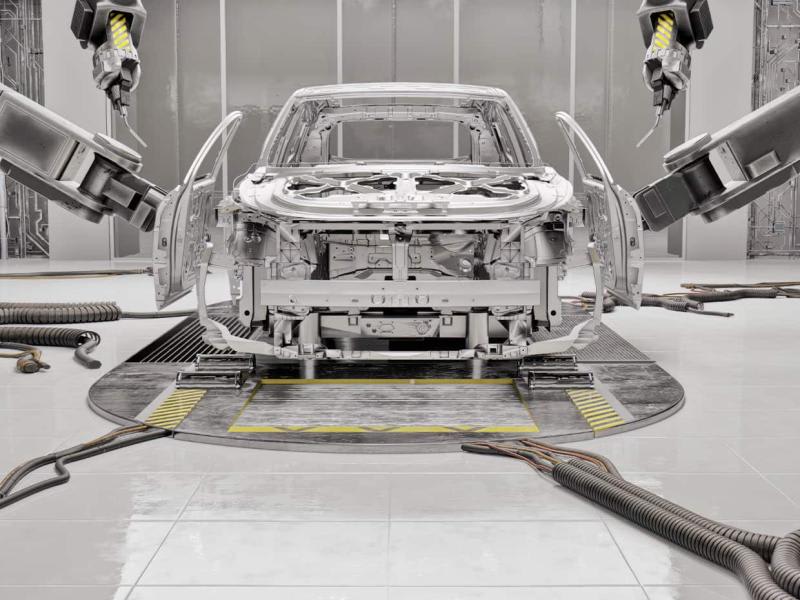Key takeaways:
*Please note: All currency denominations marked with ‘$’ are in USD unless stated otherwise.
The automotive industry is many things, but it is never idle; it thrives on the pulse of innovation, resilience in hard times, and mobility transformation. Every year brings with it new shifts in technology, consumer behaviour, and market dynamics, all of which shape and build automotive as a cornerstone industry of the world. Now, as 2025 comes into focus, the energy is electric – quite literally.
Building on the trends covered in our 2024 automotive outlook, we will explore how they have evolved in the current landscape. From the growth of the electric vehicle (EV) market’s new players and consumer shifts to the increasing relevance of cyber security as vehicles become ever more digitally integrated. Lending their professional insights are some of RSM’s global automotive leaders: Larry Keyler, Partner, Global Automotive Leader, U.S.; Forrest Wu, Partner, China; Jim Ward, Partner, U.S.; Mark Ludwig, National Leader, Trade and Tariff Advisory Services, U.S.; Grand Lui, Partner and Manufacturing Leader, Canada; Markus Mühlenbruch, Partner, Germany; and Saúl Villarreal, Office Managing Partner, Mexico.
With 2024 now firmly in the rearview mirror, let us dive into how those trends have developed into 2025 and what that means for middle-market organisations for the year ahead.
Electric vehicle trends in 2025
Still not the EV revolution once thought but still plenty of growth
Figures from the last few years show that the EV adoption rate is still slow at a global level. However, the share of cars that are electric (hybrid and full electric) continues to rise. Also, despite the slowing adoption rate, data has shown that the number of electric and hybrid vehicles actually on the road has dramatically increased (from 26 million in 2022 to 40 million in 2023). The EV market is expected to continue growing well into the 2030s. Regardless, with the continued global slowdown of EV adoption, we can also expect original equipment manufacturers (OEMs) to follow suit, with a decrease in the level of production, especially in the West.
“The evolving global legislation and regulations will bring some acceleration to the necessity of EV adoption. Critical access to charging stations and related infrastructure will impact timing and overall adoption rate. Continued education of consumers on ease of use and functionality of EV options and operations will bring some acceleration to consumer acceptance.”
Larry Keyler, Partner, Global Automotive Leader, United States
China remains dominant but new players are also making noise on the EV scene
China’s automotive industry is young compared to some of the other global players; however, the latest statistics from the International Organisation of Motor Vehicle Manufacturers, China sold approximately 32.2% of the world’s total output. This puts China firmly in the lead with regards to output. The market share with EVs specifically is even greater, manufacturing 58% of the world’s electric vehicles. While China’s dominance in EV and automotive production at large is not anything new, the movements being made in emerging economies outside of China are.
In these regions, shared mobility options like vans, minibuses, and two- and three-wheelers are more common and often electrified due to their affordability. In India, for example, electric car sales rose by 70%, driven by government incentives and new models, though future growth may be impacted if it sees subsidy reductions.
Moving further east, Thailand's electric car sales quadrupled, aided by subsidies and Chinese carmaker investments, positioning the country as a potential EV manufacturing hub. Thailand’s neighbours in Vietnam saw their electric car market expand significantly, led by VinFast, which has also entered North American markets and Malaysia has seen a tripling of electric car registrations, supported by tax breaks and infrastructure development.
“China continues to be a major force in the EV market, especially in production and supply. However, the developments in other emerging economies are also noteworthy, indicating a dynamic and evolving EV landscape in the Asia Pacific region. These emerging markets are poised to play an increasingly important role in the future of the EV industry, alongside China's continued prominence.”
Forrest Wu, Partner, China
In Latin America, much like other regions, the electrified vehicle fleet is still only a small share of the total vehicle fleet; however, that share is growing. The Latin America Energy Organisation (Olade), released a report showing that with the increase in supply, lower prices and tax incentives, Latin America and the Caribbean have great potential for EV growth. The fleet of light-duty EVs has grown in the last four years by more than 14 times with a very significant, 17-times increase in the fleet of plug-in hybrid vehicles (PHEVs). Battery electric vehicles (BEVs) have increased 12-fold in this period. Brazil is leading the way by a large margin, followed by Mexico, Costa Rica, Colombia and Chile, respectively.
"The region’s shift toward cleaner energy solutions, supported by supply chain innovation and growing infrastructure investments, signals a pivotal moment for industries to contribute to sustainable mobility. With countries across the region increasing their electric mobility capability, the groundwork for long-term growth and collaboration is solidifying."
Saúl Villarreal, Office Managing Partner, Mexico
Technology in the automotive industry
Connected, autonomous, shared, and electric (CASE) vehicle technologies remain a strong focus in automotive markets
In 2023, the global connected car market was valued at $80.87 billion and projecting remarkable growth. It is expected to expand from $95.14 billion in 2024 to $386.82 billion by 2032, reflecting a robust compound annual growth rate (CAGR) of 19.2% over the forecast period according to some figures.
Interestingly, however, a separate report indicated that two-thirds of people are unfamiliar with the concept of a connected car despite people being more likely to pay a premium for connected car features like driver assist, touchscreens, and smartphone integration. When it comes to the benefits of connected cars, it seems that drivers are more willing to allow for data collection, too. The same report states that 68% of drivers believe car companies should collect personal data, but only 5% agree to unrestricted collection. Most favour an opt-in approach (63%), and many are willing to share data for benefits, with 67% open to lower insurance rates, 43% for personalised features, and 36% for improved safety options. As will be discussed later, with more data being collected for premium features, the inevitable concern for data security is raised, and cyber security threats loom overhead.
“The pace and continued investment of research and development will be critical to the sustainability of the growth trajectory of connected, autonomous, shared and CASE vehicle technologies,” says Keyler. “Companies will need to balance these investments with expectations of ROI to the investors and stakeholders. Consumer education on and security of data collected will be critical for the long-term resiliency of the industry.”
The autonomous vehicle (AV) market is on an impressive growth trajectory, expected to surge from a market value of $1,921.1 billion in 2023 to a staggering $13,632.4 billion by 2030, with a CAGR of 32.3%. A major driver of this growth is the increasing focus on commercial applications, such as logistics and ride-sharing services. Advances in AI, sensor technology, and connectivity are also playing a key role in improving the safety and adoption of autonomous vehicles.
Additionally, looking at supply chains, AI and machine learning are driving the rise of autonomous logistics systems that can self-optimise routing, scheduling, and inventory management. These systems aim to minimise human intervention, improve decision-making, and enhance overall efficiency, paving the way for smarter supply chain operations.
However, regulatory hurdles and the complexity of navigating diverse driving environments remain significant barriers. On the bright side, partnerships between automakers and tech companies are fuelling innovation and accelerating development, bringing their vision of safer, smarter transportation closer to reality.
Cyber security in the automotive industry
An increasingly connected automotive landscape is an increasingly vulnerable landscape
The strong focus on technological advancements in the automotive sphere has also meant that cyber security is becoming a larger concern in a historically unconcerned industry. Threats like supply chain attacks, data breaches, ransomware, and state-sponsored intrusions are on the rise. Of course, the danger does not stop with vehicles as smart infrastructure is also at risk, potentially jeopardising safety and operational reliability.
The numbers paint a stark picture. By the second quarter of 2024, global cyber-attacks had surged, with organisations facing an average of 1,636 attacks per week—a 30% year-on-year increase. North America bore the brunt, accounting for 58% of publicly extorted ransomware victims. Manufacturing was not spared either, representing 29% of global ransomware targets, an alarming 56% rise over the previous year.
The financial impact is equally alarming. Ransomware-related costs in the automotive industry skyrocketed from $74.7 million to $209.6 million in just the first half of 2023. System downtime caused by these attacks reached $1.99 billion, compared to $1.3 billion in 2021.
To address these threats, proactive cyber security is a must for automakers and their partners across the value chain. Robust IoT (Internet of Things) security, regular software updates, and well-prepared incident response plans are the essential building blocks of a strong cyber security strategy. Regulatory efforts are also stepping up. New frameworks, like the EU’s Digital Operational Resilience Act (DORA) which became effective in January 2025, aim to strengthen protections for software and sensitive data, helping the industry better defend against evolving cyber threats.
“Cybersecurity risks can be introduced due to the numerous third-party suppliers involved in the automotive supply chain. A weak link in any part of the supply chain could impact the vehicle and the reputation of the OEM. Automotive suppliers should critically evaluate their cybersecurity programs to ensure they meet the current and future requirements set out by the OEMs.”
Grand Lui, Partner and Manufacturing Leader, Canada
Sustainability, regulations, and supply chain challenges in automotive manufacturing
OEMs are juggling more regulations with fluctuating demands and ongoing chip shortages
Global manufacturing in 2025 is seeing continued turbulence as it tries to strike a balance between adopting disruptive technologies, managing material shortages, and staying compliant with evolving sustainability needs and regulations.
The state of sustainability
The global automotive industry, responsible for 10% of the world’s carbon dioxide emissions, faces ongoing pressure to overhaul its practices. However, the landscape is proving difficult to steady with an intricate maze of regulations that differ by country or region and lack a unified benchmarking process for sustainability.
“In Europe, sustainability plays a central role in automotive production, as the EU is pursuing strict emissions regulations and climate targets,” says Mühlenbruch. “Car manufacturers increasingly need to transition their production to e-mobility and integrate more sustainable manufacturing processes, such as the use of recycled materials and green energy.” He continues, “The main challenges in the supply chain are the complex supply of raw materials, especially for batteries, and the need to replace fossil fuels in logistics. Transparency and sustainability in global supply chains are also often difficult to ensure.”
The EU’s Green Deal and its accompanying “Fit for 55” initiative aim to cut carbon emissions drastically by 2030, piling new expectations on manufacturers to reduce their environmental impact. Adding to the challenge, measures such as stricter Euro 7 tailpipe standards and updated rules on battery recycling demand deeper innovation within supply chains and operations.
“With the EU taxonomy and emissions regulations, the EU sets strict standards that oblige manufacturers to comply with environmental and social requirements. Innovation, cooperation between industry and politics and investment in research and sustainable technologies are required to overcome these challenges.”
Markus Mühlenbruch, Partner, Germany
On the other side of the globe, in Asia, China has implemented a landmark energy policy, aptly named the ‘Energy Law’, as of January 2025. The law emphasises a cleaner and more efficient use of fossil fuels, placing a higher emphasis on sustainability and developing renewable energy infrastructures. This comes as China continues to make their presence known in the global EV scene, with ramped-up production and dominance in the international EV market.
“The Asia Pacific region is making significant progress in automotive sustainability,” says Wu. “China's leading EV production landscape and its new 'Energy Law' are driving cleaner energy use and renewable infrastructure development. Other emerging economies like Vietnam, Thailand, and Malaysia are also showing strong growth in the EV market, supported by government incentives and infrastructure improvements. These efforts are accelerating the transition to electric mobility and contributing to global sustainability goals.”
In Latin America, the pace is a bit more varied. Brazil’s ongoing Rota 2030 programme incentivises energy-efficient technologies and biofuel use, while Mexico enforces strict emissions limits on diesel engines, pushing manufacturers to adopt cleaner solutions. At the same time, a limited EV infrastructure and uneven policy application dampen the pace of meaningful progress throughout the region. Going further north, the U.S. is seeing a big focus shift away from sustainability-oriented policy; a move that will shift manufacturing and market dynamics throughout the nation whilst potentially disrupting the Latin American manufacturing scene as we will discuss later in this outlook.
Whilst the U.S. may be bucking it, there is certainly a global trend towards a more sustainability-forward manufacturing scene. However, as with all complex bodies of rulesets, differing rules and regulatory mandates across the globe make it easier for international automakers to fall foul of compliance. The pressure is certainly on.
Chip shortages remain a major thorn in automotive’s side
The ongoing global semiconductor shortage continues to cast a shadow over manufacturing progress, particularly for industries such as automotive and electronics. While efforts are underway from many different automakers to expand fabrication capacity, lead times for chip production remain long with little sign of a solution in the near future.
The shortage may not be as bad as it was in the early 2020s; however, even with a larger output, a report has found that only 26% of organisations that are reliant on these chips have a sufficient supply. This leaves the vast majority of companies concerned with their supply and wanting for more.
“It remains important during 2025 for the industry to remain aware of the delicate balance of semiconductor supply chains and monitor the potential impacts other industries, such as telecommunications, can still have on an industry that utilises more mature chips which are less profitable to the semiconductor supply base.”
Jim Ward, Partner, United States
The shortages have forced manufacturers to delay product launches and reduce outputs, among other issues. Asia, home to key production hubs, remains at the epicentre of attempts to address this crisis, with nations like Taiwan investing heavily in scaling chip production. Additionally, Europe and the U.S. have sought to bolster their chip and semiconductor production with the ‘European Chips Act’ and the ‘CHIPS and Science Act’, respectively. Whilst these acts have been active for some years now, the landscape has not changed drastically. Until these efforts bear fruit, the industry will need to focus on mitigating risks and prioritising demand effectively.
Market shifts in the automotive industry
There is likely to be some push and pull on the international scene
2025 is shaping up to be an interesting year for automotive with regards to global shifts in the market with a mixed bag of potential harmony and disruption. In December 2024, the European Union and Mercosur countries (Argentina, Brazil, Paraguay, and Uruguay) finalised a long-awaited free trade agreement aimed at boosting bilateral trade and investment, establishing stable trade rules, and promoting sustainable development and workers' rights. This agreement is expected to drastically enhance automotive trade between these regions.
This deal comes at a time when car sales in the EU have seen a noticeable dip as consumer preferences shift. Data suggests a decline in car sales across most categories, particularly traditional fuel vehicles like petrol and diesel, which saw significant drops in market share and registrations. While BEVs and PHEVs showed some growth in September 2024, the year-to-date figures for BEVs are still lower than last year, and PHEVs also experienced a notable decline.
“Following the failed introduction of e-mobility across the board, the European automotive industry is facing one of the biggest challenges in the history of the industry,” says Mühlenbruch. “This is due to a variety of reasons. The markets to be considered are in the USA, China and Europe. In addition to new trade barriers and strong, partially subsidised competition, these are in particular the technological challenges and challenges in the supply chain when extending the life cycle of conventional drive technology.”
In the United States, the newly appointed administration has issued several executive orders that will likely have drastic impacts on both global and national automotive markets. One such order significantly impacts the future of EVs and EV infrastructure by rolling back policies that once supported their growth. It eliminates mandates that favour EVs, emphasising consumer choice and opposing regulations that make gasoline-powered vehicles less accessible. Subsidies and incentives for EVs are also under scrutiny, with plans to reconsider or eliminate government-imposed market advantages that favour them. Crucially, the order halts federal funding for EV infrastructure projects, such as charging station programs, until they align with the administration’s policy goals.
Paired with the revocation of other climate-focused directives, as well as withdrawing from the Paris Agreement means that we may see market dynamics shift towards traditional internal combustion engine (ICE) vehicles in the U.S. as manufacturers are less restricted by sustainability-focused regulations. Without subsidies, demand for EVs on the consumer end could also drastically decrease as was recently seen in Germany after government incentives ended. This may also see American automakers finding more challenges in exporting vehicles to regions in which regulations are more stringent.
The recently proposed 25% tariffs on imports from Mexico and Canada, while temporarily delayed, may also have a drastic impact on the global automotive supply chain. With many big names, such as Volkswagen, BMW, and Ford, having manufacturing plants in Mexico and both countries seeing around 90% of their auto exports go to the U.S., these tariffs could have a huge knock-on effect on global automotive trade dynamics throughout the value chain in 2025.
“The new U.S. administration is keen to drive manufacturing in all its forms back to American shores, underscored by both the forthcoming 25% tariffs on imported steel, aluminium, and their derivatives. This is in addition to the most recent messaging that imported autos (along with semiconductors) will also be hit with 25% tariffs. Notably, this is all on top of the latest additional 10% tariffs on Chinese products as well as the potentially upcoming reciprocal tariffs on all countries.”
Mark Ludwig, National Leader, Trade and Tariff Advisory Services, United States
Conversely, in Europe, regulations are scaling up in preparation for the EU ban on new ICE vehicles by 2035. Chinese EV automakers’ expansion into new markets, including Europe, other Asian countries, and Latin America as previously mentioned, could see a completely new global EV landscape. Perhaps the biggest shift here is in a new manufacturing landscape, with new decentralised hubs across the globe producing EVs for local markets.
The takeaway
2025 may prove a bumpy ride, but it will certainly be an interesting one
The automotive industry stands at a thrilling crossroads, where innovation meets complexity and opportunity rides alongside challenge. The industry will continue to experience disruptions from geopolitical headwinds to regulatory and legislative developments, data security and economic challenges. Maximising the ROI to investors and stakeholders while remaining competitive will be priorities of the industry. The continued global expansion of various players will require a strategic focus on supply chain efficiencies and may bring transformation and consolidation in the industry.
As we look forward to 2025, RSM’s automotive professionals predict a slowdown overall in the growth of the industry as well as a reduction in overall margins and profitability. Many OEM’s are already revisiting original forecasts and realigning through-put and production schedules accordingly. Automotive suppliers are renegotiating their vendor/supplier contracts to align with these new predictions. What lies ahead is not just a continuation of trends but the potential for transformation that pushes the boundaries of how we move, connect, and thrive. Buckle up—big changes are on the way.
“In closing, notwithstanding some headwinds, we do see some light at the end of the tunnel. 2025 will see transformative autonomous technologies; a continued consumer acceptance of hybrid vehicles; and an acceleration of advanced manufacturing practices across the assembly and distribution channels of the global automotive supply chains. So much more to experience and so much more opportunity ahead for the industry in 2025!”
Larry Keyler, Partner, Global Automotive Leader, United States
Contributors











